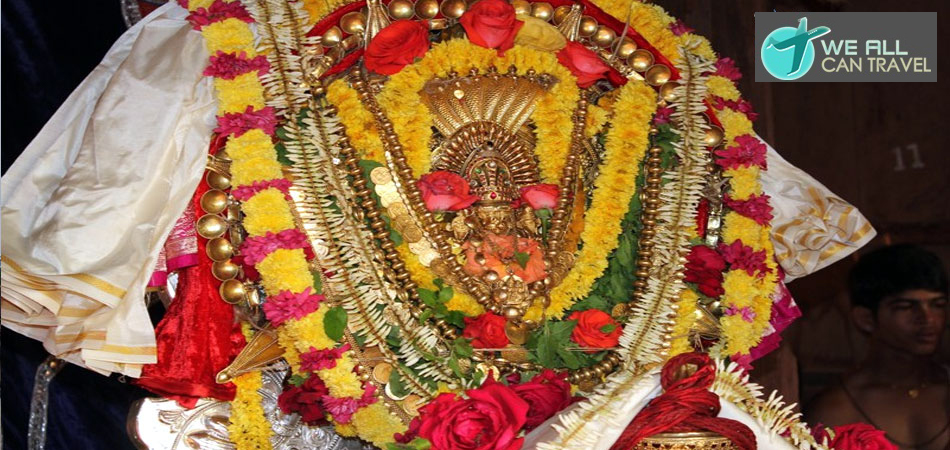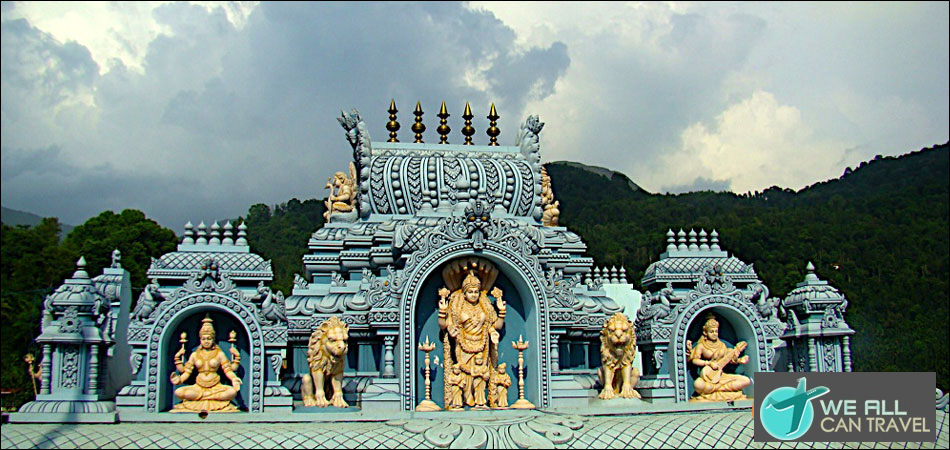Vaishnodevi Temple
Nestled between the folds of the Trikuta Hills, 56 kms. to the north of Jammu, the Shrine of Vaishno Devi Ji has been an abode of worship for the pilgrims since ages. The holy Shrine of Mata Vaishno Devi Ji is unique as it contains the holiest of holy Pindis manifesting Mata in her three forms i.e. Maha Kali, Maha Lakshmi, Maha Saraswati. Each form represents a particular attribute.
MAHA KALI represents Tam Guna, Tam Guna means darkness. In her manifestation of Kali, the goddess inspires her devotees to constantly fight the darkness and never to give up the path of righteousness.
MAHA LAKSHMI represents Raj Guna, Raj means prosperity. In this manifestation, the goddess blesses her devotees with wealth and prosperity for their better life.
MAHA SARASWATI represents Stava Guna, Stava means wisdom and knowledge. This manifestation of the goddess enables her devotees to distinguish between good and bad and help them to adopt the right path in life.
Combination of these three attributes in a single Shakti is known as MATA VAISHNO DEVI JI and this unique combination is what makes it revered all over the world, and the pilgrims flock around to seek these divine blessings.
The Total length of the holy cave is about ninety eight feet. The symbols of a large number of Gods and Goddesses of the Hindu Pantheon can be seen in the holy Cave. At the mouth of the original tunnel to the holy cave can be seen the Vakra Tunda Ganesha on the left hand side of the rock face.
Adjacent to Lord Ganesha can be seen the depiction of Lord Surya and Lord Chandra. When one crawls into the holy cave through the natural tunnel one crosses over the boulder symbolising the body of Bhairo Nath who was beheaded by the Goddess at the entry point to the holy cave. The boulder is fourteen feet long.
After this can be seen the image of Lord Hanuman called Veer Langur who said to have faught with Bhairo nath. The pilgrims have to wade through water beyond the Veer Langura point. Twenty three feet beyond Veer Langur, on the left upper hand side, the roof of the cave flares out and the weight of this over hang appears as if resting on the innumerable heads of the Shesh Nag. Immediately below the Shesh Nag can be seen the symbols of Shankh, Chakra, Gada and Padma. Higher up, almost touching the ceiling of the cave are the images of the five Pandavas, the Sapta Rishi, the image of the divine cow- Kamdhenu, Brahma and Vishnu and Shiva and Parvati. Three feet further, on an elevation some what below Shiva and Parvati, can be seen the Khamba. Diagonally below this, at the water level can be seen the Yantra with innumerable mystical signs and symbols inscribed on it. Twenty two feet beyond this point is located the Sher Ka Panja symbolizing the lion which is the mount of Mata Vaishno Devi Ji.
The distance from the entry point to the Sher Ka Panja is fifty-nine feet. Thirteen feet beyond this, immediately above the head of the worshipper, is Hood of Shesh Nag which appears as if bearing the weight of the roof of the cave at this point. The length of the cave up to the main hood of Shesh Nag is seventy two feet. Six feet further, on the left hand side, are the images of Shankar and Gouri. Thirteen feet beyond it are located the holy Pindies of "Mata Maha Kali Ji", "Mata Maha Lakshmi Vaishno Devi Ji," and "Mata Maha Saraswati Ji". The length of the Cave up to this point is ninety one feet. To the right of the holy Pindis on the upper side are the depictions of Ganesha, Surya, Chandra and Goddess Annapurna. Slightly behind the holy Pindis, on the right hand side can be seen the symbol of the seated Sinha Raj. A little ahead of it can be seen the full hand of the Goddess raised in the Varad Hast or the boon granting pose. Immediately opposite the Holy Pindis is the natural image of Lord Pashupati Nath. Water gushes out of the base of the holy Pindis and flows out of the holy Cave. It is known as Charan Ganga and this water is collected in small containers by the devotees and taken home. The same water is also channelised to the bathing ghat and the devotees take a bath in this water before they join the queue for Darshan of the holy Pindis.The holy Pindis though depicted in its three manifestations at the upper most part is basically one petrified rock at the bottom which is 5'-6" tall.
 >> Agasteeshwara Temple
>> Agasteeshwara Temple >> Anantha Padmanabhaswami Temple
>> Anantha Padmanabhaswami Temple >> Ananthasana Temple
>> Ananthasana Temple >> Annapoorneshwari Temple
>> Annapoorneshwari Temple >> Arunachaleshwar Temple
>> Arunachaleshwar Temple